While some people overreact towards flies, it’s tough to fault anyone for panicking when they encounter a female horse fly. These pests live up to the phrase “vicious bloodsuckers” despite being related to regular houseflies.
Surprisingly, they do have some environmental benefit and often breed in protected areas, making it impossible to completely get rid of horse flies.
The good news is that the very thing that makes it impossible to destroy the entire horse fly population also makes it more enjoyable to kill them, knowing you can never kill enough to threaten the environment.
The term “horse fly” is often misused, so it’s always a good idea to confirm your target is actually a horse fly before investing in control methods that may not work on other fly or bug types.
Getting to Know Horse Flies
Horse flies are a plague that thankfully only strikes in numbers during a few months of the year. Despite large house flies being referred to as horse flies, the latter is a separate species that is a lot worse than a simple bug that vomits all over your food.
So notorious are the females during breeding time that they appear in Shakespeare as the “maddening gadfly”. Because of their hunting methods, it’s easy to get rid of horse flies once you verify that you’re dealing with one.
Horseflies 101
There are approximately 4,455 species of horse flies in the Tabanidae family. While the entire family is often nicknames horse flies, the real deal technically belong to the 3,000+ member subfamily Tabaninae.
Of these, a whopping 1,300 belong to the genus Tabanus. Members in this family tend to be named for the animal they most prefer to attack, such as buffalo flies and moose flies. Interestingly, these sub-groups often take on a different appearance from other Tabanidae.
What Does a Horse Fly Look Like?
Earning the nickname “dun-fly” due to its muted colors, the horse fly has dull yellow markings that resemble those of a bee. They have very large eyes, very small antennae, and very sharp mouthparts. Their bodies are wider than the average fly and can grow as large as an inch in length.
Do Horse Flies Bite?
As mentioned earlier, only the females actually bite, and even then, only when they are preparing to reproduce. These bites are more painful than other types of bites and can lead to allergic reactions, as well as the risk of bloodborne diseases and parasites. In a few extreme cases, the bite has been known to cause fatal anaphylaxis in humans.
Where do Horse Flies Come From?
If you ask someone who’s just been bitten, the answer is “from the deepest, darkest depths”. A more scientific explanation is that the horse fly prefers to breed in moist soil near large bodies of water, but can roam up to 30 miles away.
While they prefer wooded regions, they can be found in almost every land-based region except for polar.
Horsefly Life Cycle
It all begins with a mating swarm, and each species has its own calendar for this event. Interestingly, mating rituals take place at visible landmarks, such as a hill in the middle of a field.
Female horseflies need a blood meal to lay her eggs, which are in clusters of up to 1,000 eggs. The cluster is deposited in vegetation or on rocks near water sources, and are initially white but darken as the larva grows inside.
After about six days, the larval stage emerges using a specialized spike and makes its way to the moisture. The amount of dampness needed for a larva depends on its genus. They’ll molt between six and 13 times, with some species entering diapause and more tropical species reaching adulthood and mating multiple times per year.
The glossy brown pupae take approximately two weeks to complete their metamorphosis. Males usually emerge first, and the adult stage generally lasts long enough for all the pupae to open and the adults to hold their mating flight.
What do Horse Flies Eat?
Despite popular opinion, only the females are responsible for delivering painful bites and feeding on blood, which they use to aid in reproduction. Overall, adult horseflies prefer plant nectar and are actually vital for the survival of certain plants. You’ll also find them hanging out near locations containing manure piles, such as compost heaps, barn stalls, and near water troughs.
Meanwhile, the horse fly larva is predatory and sometimes cannibalistic. They’ll help get rid of other insect pests and are a tasty treat for grub-loving birds such as starlings.
Of course, no matter how beneficial these pests can be, the risk of suffering female horse fly bites is enough to justify killing these annoying insects on sight.
Health Risks of Horse Flies
The majority of health risks come from females, which need to harvest blood to reproduce. These bites often transmit bacteria and can also cause allergic reactions. Even in the best scenario, an encounter with a hungry female can be really painful.
What Does a Horse Fly Bite Look Like?
Due to the way horse flies cut into the skin, bite marks and symptoms may vary from one victim to the next. The bite itself will become inflamed, sore, and itchy and will either welt or become a rash. Other more extreme symptoms may also occur, such as dizziness or wheezing.
Basic Treatment
You’ll want to wash and disinfect the bite early on to avoid possible infection. In addition to taking any allergy medications necessary, you can use first aid sprays and salves, such as After-Bite, to alleviate symptoms.
Effects of Horsefly Bites on Animals
The contaminants carried by horseflies, as well as the effects of the bite itself, can wreak all sorts of havoc with livestock. It can result in the transmission of anthrax, reduce milk production, and even cause enough blood loss to kill a horse or cow when multiple horse flies are feeding.
Horse Fly vs Deer Fly
Deer flies belong to the subfamily Chrysopsinae which makes them technically a type of horse fly, although there are several differences in appearance and behavior. Deer flies (which don’t look anything like deer) have dark bands across their wings and generally bright coloration, as opposed to the clear wings and dull colors of a horse fly. Additionally, their bodies tend to be slimmer and smaller, although they’re still bigger than houseflies.
Horse Fly vs House Fly
While the horse fly and house fly generally look nothing alike, common nicknames mean the latter is sometimes referred to as a “horse fly”.
The cause of this misnomer is from descriptions of some house flies being “as big as a horse”. House flies don’t feed on blood, but they do carry a high amount of bacteria that can contaminate any food and possessions they come into contact with whether in the house or garage.
See Also: How to Get Rid of Cluster Flies in the House
How to Get Rid of Horse Flies
Normally, I’d warn against exterminating a critter, but there are no restrictions or major environmental impacts to killing every horse fly you see. The fact that they often make their breeding grounds in protected lands means any potential environmental impacts of destroying those that venture onto public or private land remain minimal.
The following are just a few of the many potential ways to get rid of these pests.
The Humble Horse Fly Trap
There are several traps available to help you get rid of horse flies. Some of the most effective are:
- Bug Zappers: This is one of the most satisfying kill traps in the world. Unwanted bugs are attracted to the light and are electrocuted with a satisfying sound. The corpses can then be fed to pets or carnivorous plants. Make sure the slats are big enough for a horse fly to enter.
- Flies-Be-Gone: This trap uses a plastic bag and bait. The flies enter through a funnel and can’t figure out how to leave.
- Fly Paper: The standard in homes for generations, common fly paper will catch horse flies as easily as common house flies and fruit flies.
- Horse Pal or H-Trap: This is another commercial trap which can provide satisfaction. Designed to attract visual hunters, the horse fly will approach what looks like an attractive meal only to get trapped in a metal container which slowly cooks the pest to death using common sunlight.
Chemical Sprays
You can use chemical sprays that are relatively safe and contain natural pesticides. The first option is a common soap spray, which can be used to suffocate most insect pests.
The ratio of the mixture is 4 tbsp dish soap (Dawn is safe around birds, squirrels, and other backyard critters), 2 cups vinegar, and 1 cup warm water. Just shake to mix and spray. A nice benefit is that you can safely spray plants with this mixture.
Another effective option is to use pyrethrins. This natural insecticide is extracted from Chrysanthemums and available in concentrated form at farm supply stores or online. Farmers use this to spray or bathe their horses and cattle between once per day and once every other day.
Pyrethrin is known to greatly reduce biting incidents. Be sure to buy a mixture specifically for the animal you wish to spray, as different concentrations are necessary for different animals.
It’s considered to be one of the safer types of pesticides since it is naturally derived and breaks down quickly. Thus it doesn’t persist in the environment like many artificial pesticides. However, it’s still a pesticide and caution should be taken. In fact, pyrethrins can become toxic to humans in larger quantity so be sure to follow the recommended dilution rate.
In addition, while pyrethrin is generally safe around dogs, birds, and most other animals, it can be quite harmful to cats and it is especially toxic to honey bees. Caution should be taken over its use in these situations.
Related: 5 Best Horse Fly Sprays
DIY Corner: Two Types of Homemade Horse Fly Trap
You can build your own traps, which work just as well as commercial products. These fall into two major categories: container traps and sticky traps.
Container Traps
Admittedly, there are a lot of variations to a theme with these traps. You can use the inverted soda bottle traps made for house flies by adding some rotting meat or acetone. More commonly, a variation of the Manning trap is used. One version of this trap is as follows:
- Construct a tripod stand (or use an existing one) that’s five feet high. You can also build a four-legged frame.
- Place a cloth or piece of plastic on top of the stand
- Cut a small hole in the middle of the top surface and cover with a small funnel.
- Sit a plastic bottle upside-down over the mouth of the funnel and secure it using tape.
- Attach a heavy string or twine to the underside of the tripod and add a dark, medium-sized ball to the dangling end.
- Trim your cover so there’s a good two feet of clearance from the ground and the black ball is clearly visible.
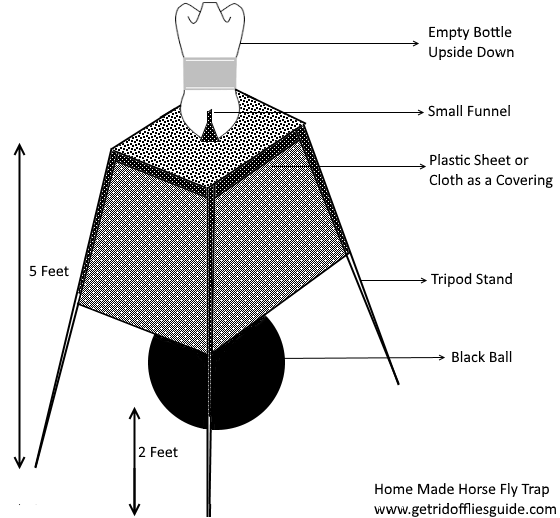
Sticky Traps
These are traps which use fly paper instead of a bottle. One easy version is to stick fly paper near a light source that’s attracting flies. Another easy-to-make sticky trap is a variation of the Manning trap which uses a stool suspended from the ceiling or other stable surface.
A dark ball is suspended underneath and the legs of the stool are loosely wrapped in fly paper so departing flies will potentially get stuck.
How to Keep Horse Flies Away
As in most cases, the best offense against horse flies is a good defense. It’s not common to find horse flies in the house, but they absolutely love hanging around your swimming pool and other damp areas.
You probably won’t be able to eliminate their breeding grounds. However, you can still get rid of horse flies by making your own land more unappealing to these pests.
Defending the Home
Prevention is very basic when it comes to the home. Keeping the house clean will help you avoid a whole mess of potential bug invaders. Horse flies also hate smoke, so burning candles or incense can help keep them away. Citronella candles will also deter other biting insects.
Defending the Pool
You’ll likely see the biggest problem with your backyard pool or pond, unless you have livestock. Covering these during the height of horse fly season will be a big help. You should also install light traps to distract and kill any invaders that decide to hang around the pool area.
Read Also: How to Get Rid of Biting Midges
 Defending Your Livestock
Defending Your Livestock
Giving your livestock a quick coating of pyrethrin-based pesticides once every one or two days not only reduces the risk of bites, but serves as a relatively safe form of horse fly control. Protective coverings such as ear nets and face masks can protect some of the most sensitive parts from the adult flies.
Provide a sheltered retreat where horses and cattle can take cover. This can really help reduce bites, as long as you remember to screen the doors and windows.
General Outdoor Prevention
Insect repellents such as Off! work well in helping to get rid of horse flies. You can also reduce the degree of attraction by wearing light colors.
Horse flies (and other pests) are attracted to long grass and trash. Keep the yard neat and trimmed to help discourage visits. Finally, you can install some bird feeders or suet cages to attract birds, as many species will also eat insects.
- How to Get Rid of Hawks - March 8, 2024
- How to Get Rid of Pill Bugs (Rolly Pollies) - March 1, 2024
- How to Get Rid of Groundhogs (Woodchucks) - February 5, 2024

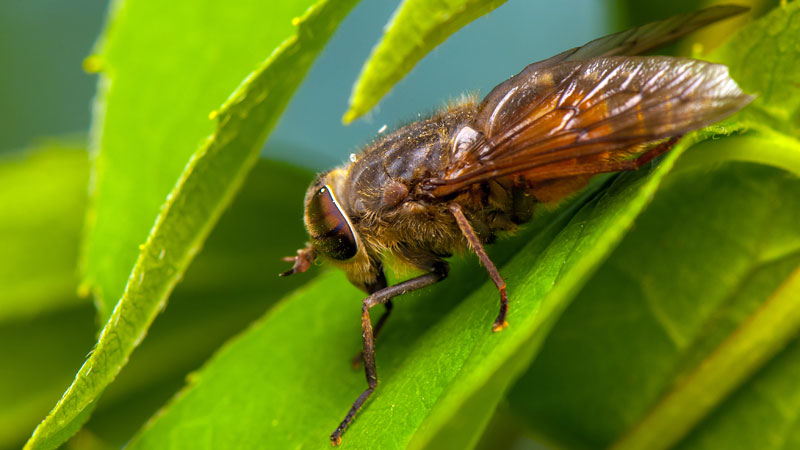

 Just tell me how to get rid of ’em.
Just tell me how to get rid of ’em.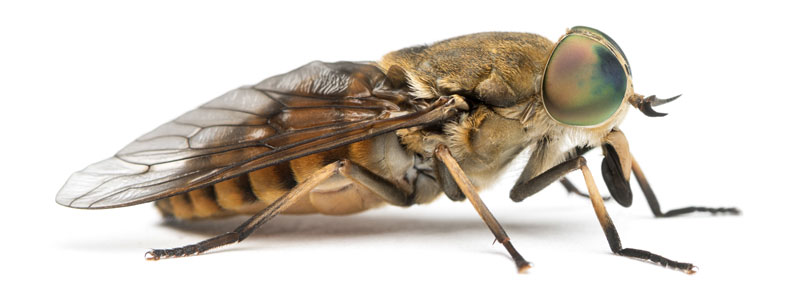
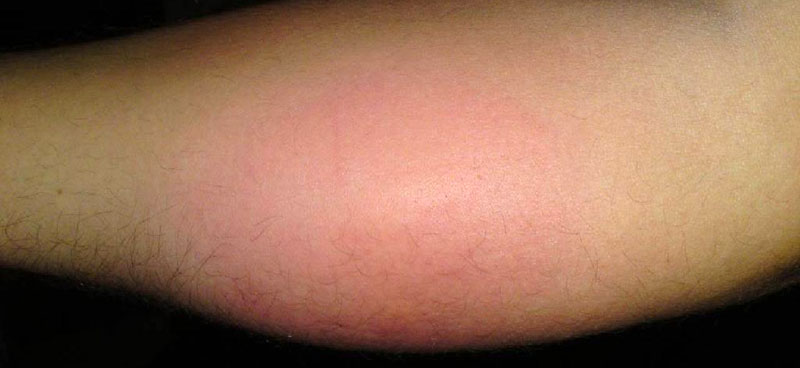
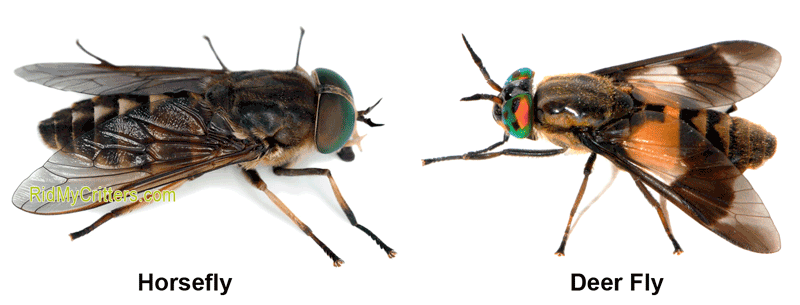

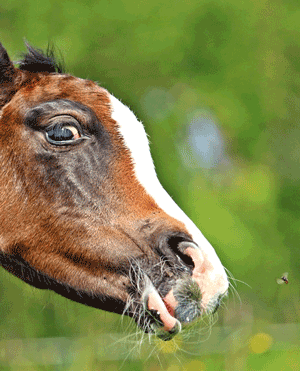 Defending Your Livestock
Defending Your Livestock
Thank you. This is very helpful. I didn’t know anything about horse flies and always had them mixed up with hornets. The ones I’ve seen are very aggressive. We were out looking at some acreage and as soon as we pulled up a couple of them started attacking our car. I was afraid to get out. I finally got out and they kept rushing at my head as to hit me or scare me out of the area.
Glad you found it helpful. Unfortunately, horseflies (especially the females) are very aggressive. As scary as it sounds, they were probably females looking for human or animal blood which they need to grown their eggs. Fortunately you didn’t get bit since it’s not the most pleasant thing.
I HATE them. They always attack us in the pool. The bite is terrible and leave a scar. They are definitely from hell
How would the soda bottle trap work if the females are out for blood?
They are attracted to the smell of the meat (blood in it). Instead of meat, you can also use a mixture of 2 cups water, 1/2 cup white vinegar, and 1/2 cup sugar. This mixture still works as an attractant/bait but doesn’t seem to work as well on females.
Immediately searched this after killing it with a slipper
One followed me all the way home, so annoying
Ive been experiencing them while camping! As soon as we get set up we had to hide in the tent. There was a burn ban so we couldn’t keep a fire going with the hopes of getting rid of them. Any suggestions for an easy camping trap or deterent? We experienced close to ten or 15 while there for a few hours. Ended up packing up and going home! They are so awful!
The black horse fly won’t fit in traps and sprays don’t work so what can I use to keep them away from my horses?
I have to deal with these for 2-4 weeks every summer. I live in an established subdivision!! Any livestock is 1/2 to 1 mile away. I think they are also attracted to the exhaust from my vehicle, because they swarm my truck every time I pull in the driveway. I have to shut it off and sit there until the fumes dissipate and the flies go away. I still get out of the truck with swatter and wasp/hornet spray in hand. I am also fully clothed, head to toe, long sleeves, long pants, socks, shoes, and sometimes a hood, no matter the temperature.
I have learned to leave the truck outside until after dark, then I move it into the garage. Yes, they generally are not around after dark. I also had to stop turning the light on in my garage during this time, because they confuse it with daylight.
A friend who used work on a horse ranch in Florida told me about a granular product that they kept in pie tins outside the barn. They never had a problem with horse flies!! And, do you know what??? Florida banned the product. This person tried to find out what the product or chemical was, but was unsuccessful. If I could only find it, outside of U.S. if necessary, I would buy it.
Best thing I have found here, so far, is a natural insect repellant called Zero-Bite, from Pyranha. I spray around both garage doors, a short brick wall next to the garage, AND the tires and bumpers on my truck. It seems to work pretty well, but you do have to reapply it (I think I did it weekly last year).
I also keep my garage doors closed, which I hate to do, because I have Feral Cats that call it home!! And, it gets pretty darn hot in there in the summer!! No, I have never seen the horse flies go for the cats, thank the Lord!!!
Needless to say, very little gets done outside around my house during those weeks.
Thanks Diane!
I was chased by one on one of my daily walks a couple of days ago — it followed me for a mile and a half and wouldn’t stop attacking me. I didn’t know what it was and I thought I had done something to upset this insect not realizing it was a horse fly that really wanted to feed off me. I had to run into a school while a stranger tried to swat the thing away from me. The fly was unfazed and continued to try to go after me. I have never experienced anything like it! I Had to have someone come pick me up. I still haven’t gone back out for my daily walk — I’m too traumatized!
Can I use blood in my horse Fly trap to attract the females?